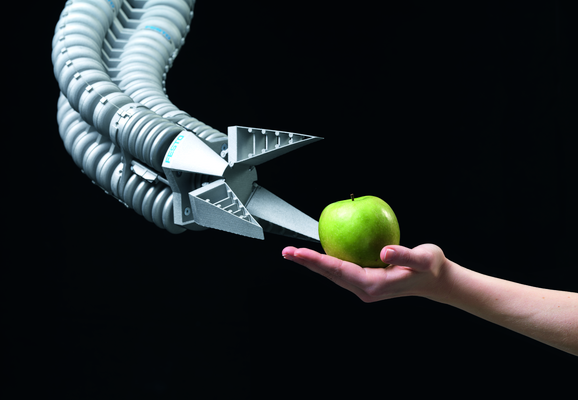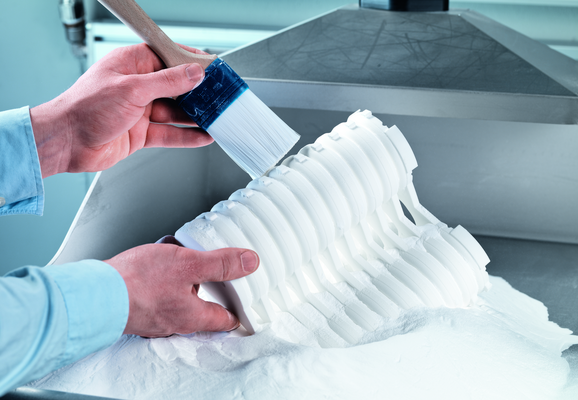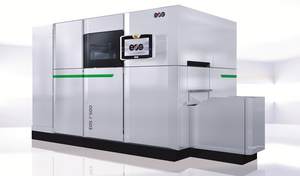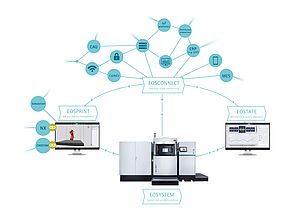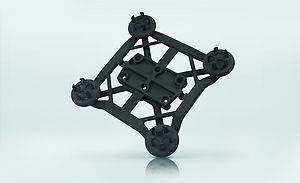Biological processes, motion patterns of living organisms or physical construction principles: Nature has countless solutions only waiting to be analysed by bionic science and translated into technological innovation.
However, it is difficult to employ conventional manufacturing techniques to make use of the solutions which Mother Nature has developed in millions of years of evolution. Festo, a worldwide leading supplier of automation technology, uses the laser sintering process for the small batch production of some of its industrial applications which are based on bionic adaptation. In 2010, the company's Bionic Handling Assistant was awarded the "Deutscher Zukunftspreis" (German Future Award), the technology and innovation award endowed by the Federal President.
Challenge
The Esslingen-based company has been gathering experience in additive manufacturing since 1995 and is now using this technology to produce several thousand parts per year. What began with concept models and functional prototypes has meanwhile developed to the level of batch production. The Bionic Learning Network, a group of renowned universities, institutes and development companies established by Festo in 2006, has made a substantial contribution to paving the way, since the technical principles of products which are derived from nature often have rather complex designs.
Implementation by means of conventional manufacturing methods is impossible or difficult and always expensive. The production method determines the design of the product which all too often leads to design restrictions. Nature's efficient construction principles, on the other hand, are not subject to such restrictions. Therefore, nature can be emulated only by a technology in which the design determines the means of production and which will ideally work in serial production as well.
Solution
One example of successful product development and production using additive manufacturing is the DHDG adaptive gripper. It has become an inherent part of Festo's production range and is manufactured on a FORMIGA P 100 supplied by EOS. Its structure is adapted from a fish fin and has two flexible bands which form a triangle to converge at the top. Intermediate webs are connected to the bands via joints at regular intervals. This flexible yet stable connection allows the gripper fingers to precisely adjust to the contour of the work piece. Even sensitive objects or objects with varying contours are gripped and transported. The particular feature is that the gripper elements already have this functionality directly after production and not only after expensive assembly procedures.
That said, laser sintering is an underlying manufacturing requirement for this design and this specific application - and there is no alternative yet.
Another example is the Bionic Handling Assistant. The flexible assistance system, which is modeled after an elephant's trunk, consists of three basic elements for spatial movement, a hand axis and a gripper with adaptive fingers.
"Its functionality and its structure that incorporates complex plastic components make it impossible to produce the high tech arm without laser sintering," says Klaus Müller-Lohmeier, Head of Advanced Prototyping Technology at Festo AG & Co. KG. With a FORMIGA P 100, a complete handling assistant can be manufactured in just four building sessions.
Results
The EOS technology makes it possible to directly incorporate functions that the final product is supposed to have. This is advantageous, since it reduces the number of parts and the additional assembly costs.
"Thanks to the design freedom the laser sintering process gives us, we can manufacture movable, flexible but also specific rigid shapes - just as they occur in nature. Our designers can work without having to observe the restrictions of conventional manufacturing techniques and fully concentrate on the implementation of the natural principle analysed," adds Müller-Lohmeier.
Moreover, the DHDG adaptive gripper is very economic, because it is about 80 % lighter than conventional grippers made of metal. The reason for this is the additive manufacturing of plastics which allows the production of especially light-weight, elastic but very strong structures. Studies have shown that the gripper elements can withstand more than five million bending cycles.
Additive manufacturing production always means tool-less production. "How cost-efficient this can be is illustrated by a customer project in which we have manufactured 12,000 components using laser sintering as an alternative technology. Tool-less production saved 40 % of the unit costs compared to injection moulding. All parts were finished within one week in just four jobs. Conventional production would have taken two months," explains Müller-Lohmeier.
Moreover, follow-up costs for auxiliary materials and devices are reduced and there is no delay occurring due to the production of tools. This enables Festo to launch its products much faster.
The high-tech robotic arm is one example of how a mainly digital process chain is implemented in industrial manufacturing. Müller-Lohmeier adds: "At the moment, we are also using the EOS technology more and more for projects that only call for limited annual quantities of a complex part. In such cases, the process is a real alternative for us to existing, often tool-based methods."


